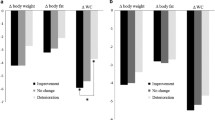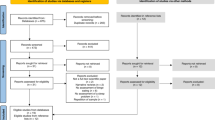Abstract
Purpose
Some research suggests that eating disorders are related to poor sleep health. To increase knowledge on the relation between sleep and eating disorders, we used a multi-method approach to examine associations between sleep, chronotype, and eating disorder psychopathology.
Methods
We investigated associations between ED psychopathology, both diagnostic categories (ascertained through self-report data) and dimensional measures, and self-report and ambulatory measures of sleep. Adults currently enrolled in a commercial weight loss program completed self-report measures as well as 1 week of ambulatory sleep monitoring and sleep diaries.
Results
Participants with full- or sub-threshold bulimia nervosa and binge eating disorder reported significantly lower subjective sleep health and greater eveningness. Additionally, greater severity of eating disorder psychopathology was associated with lower subjective sleep health and greater eveningness. Eating disorder psychopathology was generally not related to objective sleep measures. Regarding diary measures, global eating disorder psychopathology was negatively correlated with subjective reports of feeling rested.
Conclusion
Eating disorder psychopathology is associated with participants’ subjective sense of sleep quality, but appears to have little relation to objective sleep characteristics.
Level of evidence Level V, descriptive study.
Similar content being viewed by others
References
Johnson JG, Cohen P, Kasen S, Brook JS (2002) Eating disorders during adolescence and the risk for physical and mental disorders during early adulthood. Arch Gen Psychiatry 59:545–552. https://doi.org/10.1001/archpsyc.59.6.545
Cinosi E, Di Iorio G, Acciavatti T, Cornelio M, Vellante F, De Risio L, Martinotti G (2011) Sleep disturbances in eating disorders: a review. Clin Ter 162:e195–e202
Delvenne V, Kerkhofs M, Appelboom-Fondu J, Lucas F, Mendlewicz J (1992) Sleep polygraphic variables in anorexia nervosa and depression: a comparative study in adolescents. J Affect Disord 25:167–172. https://doi.org/10.1016/0165-0327(92)90002-N
Ulman TF, Von Holle A, Torgersen L, Stoltenberg C, Reichborn-Kjennerud T, Bulik CM (2012) Sleep disturbances and binge eating disorder symptoms during and after pregnancy. Sleep 35:1403–1411. https://doi.org/10.5665/sleep.2124
Vieira MF, Afonso P (2017) Sleep disturbances in anorexia nervosa. Eur Psychiatry 41:S561. https://doi.org/10.1016/j.eurpsy.2017.01.812
Soares MJ, Macedo A, Bos SC et al (2011) Sleep disturbances, body mass index and eating behaviour in undergraduate students. J Sleep Res 20:448–479. https://doi.org/10.1111/j.1365-2869.2010.00887.x
Yeh SSS, Brown RF (2014) Disordered eating partly mediates the relationship between poor sleep quality and high body mass index. Eat Behav 15:291–297. https://doi.org/10.1016/j.eatbeh.2014.03.014
Mason TB, Heron KE (2016) Do depressive symptoms explain associations between binge eating symptoms and later psychosocial adjustment in young adulthood? Eat Behav 23:126–130. https://doi.org/10.1016/j.eatbeh.2016.09.003
Vanderlind WM, Beevers CG, Sherman SM et al (2014) Sleep and sadness: exploring the relation among sleep, cognitive control, and depressive symptoms in young adults. Sleep Med 15:144–149. https://doi.org/10.1016/j.sleep.2013.10.006
Haedt-Matt AA, Keel PK (2011) Revisiting the affect regulation model of binge eating: a meta-analysis of studies using ecological momentary assessment. Psychol Bull 137:660–681. https://doi.org/10.1037/a0023660
Wu M, Hartmann M, Skunde M, Herzog W, Friederich HC (2013) Inhibitory control in bulimic-type eating disorders: a systematic review and meta-analysis. PLoS One 8:e83412. https://doi.org/10.1371/journal.pone.0083412
Della Marca G, Farina B, Mennuni GF, Mazza S, Di Giannantonio M, Spadini V, Mazza M (2004) Microstructure of sleep in eating disorders: preliminary results. Eat Weight Disord 9:77–80. https://doi.org/10.1007/BF03325049
Stice E, Telch CF, Rizvi SL (2000) Development and validation of the eating disorder diagnostic scale: a brief self-report measure of anorexia, bulimia, and binge-eating disorder. Psychol Assess 12:123–131. https://doi.org/10.1037/1040-3590.12.2.123
Stice E, Fisher M, Martinez E (2004) Eating disorder diagnostic scale: additional evidence of reliability and validity. Psychol Assess 16:60–71. https://doi.org/10.1037/1040-3590.16.1.60
Smith CS, Reilly C, Midkiff K (1989) Evaluation of three circadian rhythm questionnaires with suggestions for an improved measure of morningness. J Appl Psychol 74:728–738. https://doi.org/10.1037/0021-9010.74.5.728
Horne JA, Ostberg O (1976) A self-assessment questionnaire to determine morningness-eveningness in human circadian rhythms. Int J Chronobiol 4:97–110
Torsvall L, Akerstedt T (1980) A diurnal type scale. Construction, consistency and validation in shift work. Scand J Work Environ Health 6:283–290
Guthrie JP, Ash RA, Bendapudi V (1995) Additional validity evidence for a measure of morningness. J Appl Psychol 80:186–190. https://doi.org/10.1037/0021-9010.80.1.186
Natale V, Alzani A (2001) Additional validity evidence for the composite scale of morningness. Pers Individ Dif 30:293–301. https://doi.org/10.1016/S0191-8869(00)00046-5
Buysse DJ (2014) Sleep health: can we define it? Does it matter? Sleep 37:9–17. https://doi.org/10.5665/sleep.3298
Nunnally JC (1970) Introduction to psychological measurement. McGraw-Hill, New York
Montgomery-Downs HE, Insana SP, Bond JA (2012) Movement toward a novel activity monitoring device. Sleep Breath 16:913–917. https://doi.org/10.1007/s11325-011-0585-y
Monk TH, Reynolds CF, Kupfer DJ et al (1994) The Pittsburgh sleep diary. J Sleep Res 3:111–120. https://doi.org/10.1111/j.1365-2869.1994.tb00114.x
Smith TM, Wegener ST (2003) Measures of sleep: the insomnia severity index, medical outcomes study (MOS) sleep scale, Pittsburgh sleep diary (PSD), and Pittsburgh sleep quality index (PSQI). Arthritis Rheumatol 49:S184–S196. https://doi.org/10.1002/art.11409
Coates TJ, Killen J, George J, Marchini E, Hamilton S, Thorensen C (1982) Estimating sleep parameters: a multitrait-multimethod analysis. J Consult Clin Psychol 50:345–352
Benjamini Y, Hochberg Y (1995) Controlling the false discovery rate: a practical and powerful approach to multiple testing. J R Stat Soc Ser B Stat Methodol 1:289–300
McDonald JH (2014) Handbook of biological statistics, 3rd edn. Sparky House Publishing, Baltimore
Bei B, Milgrom J, Ericksen J, Trinder J (2010) Subjective perception of sleep, but not its objective quality, is associated with immediate postpartum mood disturbances in healthy women. Sleep 33:531–538. https://doi.org/10.1093/sleep/33.4.531
Orta OR, Barbosa C, Velez JC, Gelaye B, Chen X, Stoner L, Williams MA (2016) Associations of self-reported and objectively measured sleep disturbances with depression among primary caregivers of children with disabilities. Nat Sci Sleep 8:181–188. https://doi.org/10.2147/NSS.S104338
Assefa SZ, Diaz-Abad M, Wickwire EM, Scharf SM (2015) The functions of sleep. AIMS Neurosci 2:155–171. https://doi.org/10.3934/Neuroscience.2015.3.155
Ewing DL, Manassei M, van Praag CG, Philippides AO, Critchley HD, Garfinkel SN (2017) Sleep and the heart: Interoceptive differences linked to poor experiential sleep quality in anxiety and depression. Biol Psychol 2017 127:163–172. https://doi.org/10.1016/j.biopsycho.2017.05.011
Suarez EC (2008) Self reported symptoms of sleep disturbance and inflammation, coagulation, insulin resistance and psychosocial distress: evidence for gender disparity. Brain Behav Immun 22:960–968. https://doi.org/10.1016/j.bbi.2008.01.011
Lavender JM, Utzinger LM, Crosby RD et al (2016) A naturalistic examination of the temporal patterns of affect and eating disorder behaviors in anorexia nervosa. Int J Eat Disord 49:77–83. https://doi.org/10.1002/eat.22447
Heatherton TF, Baumeister RF (1991) Binge eating as escape from self-awareness. Psychol Bull 110:86. https://doi.org/10.1037/0033-2909.110.1.86
Van De Water AT, Holmes A, Hurley DA (2011) Objective measurements of sleep for non-laboratory settings as alternatives to polysomnography—a systematic review. J Sleep Res 20:183–200. https://doi.org/10.1111/j.1365-2869.2009.00814.x
Funding
Support for this project was provided by the Sanford Health—North Dakota State University Collaborative Research Seed Grant program. The authors were responsible for all aspects of study design and manuscript preparation. The funding source had no involvement.
Author information
Authors and Affiliations
Corresponding author
Ethics declarations
Conflict of interest
The authors have no conflicts of interest to report.
Ethical approval
The Institutional Review Boards of Sanford Health and North Dakota State University approved this study. All procedures performed in studies involving human participants were in accordance with the ethical standards of the institutional and/or national research committee and with the 1964 Helsinki declaration and its later amendments or comparable ethical standards. Informed consent was obtained from all individual participants included in the study.
Informed consent
All eligible participants completed an electronic informed consent form prior to participation in the study.
Additional information
Publisher’s Note
Springer Nature remains neutral with regard to jurisdictional claims in published maps and institutional affiliations.
This article is part of topical collection on Sleep and Eating and Weight disorders.
Rights and permissions
About this article
Cite this article
Mason, T.B., Engwall, A., Mead, M.P. et al. Sleep and eating disorders among adults enrolled in a commercial weight loss program: associations with self-report and objective sleep measures. Eat Weight Disord 24, 307–312 (2019). https://doi.org/10.1007/s40519-019-00664-1
Received:
Accepted:
Published:
Issue Date:
DOI: https://doi.org/10.1007/s40519-019-00664-1




